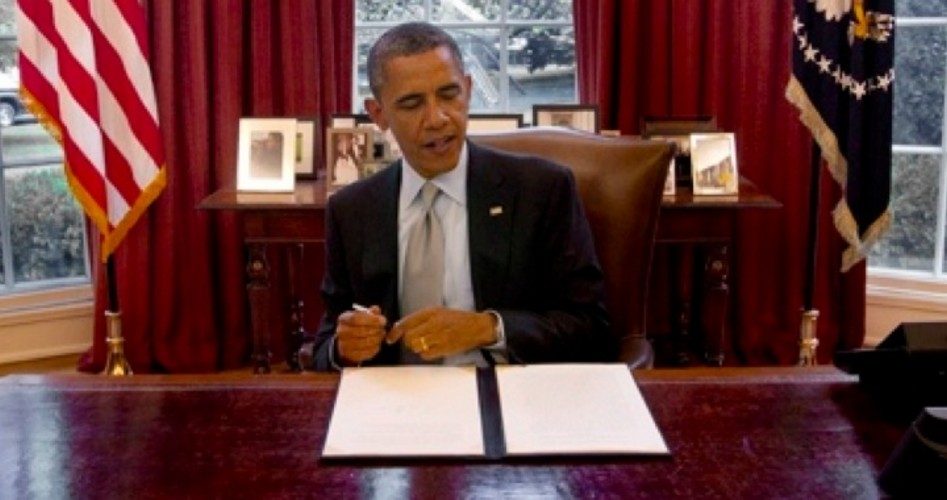
During the hailstorm of legislation that passed through Congress in the first “Hundred Days” of the New Deal, humorist Will Rogers observed that Congress doesn’t make laws anymore, “they just wave at the bills as they go by.” Now that the Supreme Court has effectively rewritten the Affordable Care Act (ObamaCare) to find the mandate to purchase health insurance constitutional and President Obama has been implementing some of his legislative agenda with executive orders, members of Congress might wonder if they really are the nation’s lawmakers.
Even though the high court invoked the doctrine of “dual sovereignty” to find ObamaCare’s economic coercion of states to expand their Medicaid programs unconstitutional, the Obama administration has found other ways to encourage states to conform to White House policy. Earlier this year Rep. John Kline, the Minnesota Republican who chairs the House Committee on Education and the Work Force, accused the administration of granting states waivers from some of the requirements of the decade-old No Child Left Behind Act “in exchange for states adopting the policies he wants them to have.”
The Department of Education on Friday announced waivers for Washington and Wisconsin, bringing to 26 the number of states where waivers have been granted. They are currently being considered for 10 other states. In making the announcement Friday, Secretary of Education Arne Duncan expressed the administration’s frustration in attempting to get Congress to amend the law:
A strong, bipartisan reauthorization of the Elementary and Secondary Education Act remains the best path forward in education reform, but as 26 states have now demonstrated, our kids can’t wait any longer for Congress to act.
While the law itself has been controversial, so has the granting of waivers on a scale that calls into question whether there is still a national program to reach the stated goal of the statute, making all students proficient in reading and mathematics by 2014.
“The more waivers there are, the less there really is a law, right?” said Andy Porter, dean of the University of Pennsylvania’s Graduate School of Education.
But the administration is using the law’s requirements as a bargaining tool un exchange for the waivers, the New York Times reported, as school districts are required to set new goals for preparing students for college or careers. The evaluations of teachers must also be tied to the achievement of students on standardized tests that so far have been used to rate schools and school districts. The shift in policy and the continued emphasis on standardized tests “is another example to me of how we’re not focused on the right things in the American education conversation today,” Joshua Starr, superintendent of schools for Montgomery County, Maryland, told the Times. Starr, who received a waiver in May, had tepid praise for the secretary.
“I have a lot of respect for Arne Duncan,” he said, “but it’s just sort of moving around the chairs on the Titanic.”
But states receiving waivers will evaluate teachers by other means besides the student achievement tests, Duncan said. Other indicators will include the number of graduates enrolled in college and reviews of teachers by students, principals, and other teachers, he told the Times in an interview.
“You have to look at multiple indicators and multiple measures,” he said. “There’s been historically a push to way oversimplify what is very complex.”
The goal of holding schools and school districts responsible for the education of poor and minority students generated widespread, bipartisan support for the No Child Left Behind Act when Congress passed the law in 1981 as the priority item on the legislative agenda of President George W. Bush. Yet both the law and its implementation have drawn sharp criticism from the political left, right, and points in between. Some conservatives have opposed the program as an unconstitutional imposition of federal authority over local and state education policies, while liberals have complained of underfunding. Critics have scorned the heavy emphasis on standardized testing and a ratings system that showed nearly half of all schools in the country failed to meet their educational goals during the 2010-2011 school year. In Virginia it was 61 percent, while in Massachusetts 80 percent of the schools fell short of the goals.
The Act itself authorizes the education secretary to grant waivers from some of its requirements, and the Department of Education states on its website: “States, school districts and other educators now have greater flexibility in how they may use federal program funds to support State and local school improvement efforts.” Yet the profusion of waivers has raised the question of whether the Obama administration is using the procedure to bypass Congress in the legislative promise, a charge that Republicans raised when the President announced an end to the deportation of illegal aliens who came to this country as juveniles. The administration has also taken executive action to prevent drug shortages, raise fuel-efficiency standards, and cut refinancing fees for federally insured mortgages, the Times noted. While Congress has not passed proposed cap and trade legislation to reduce greenhouse gas emissions, the EPA has proposed achieving that end through its rule-making authority.
Indeed, the White House website boasts of President Obama’s determination to accomplish through executive orders what Congress will not legislate, offering the following quotation (dated October 24, 2011), from the president:
Without a doubt, the most urgent challenge that we face right now is getting our economy to grow faster and to create more jobs…. We can’t wait for an increasingly dysfunctional Congress to do its job. Where they won’t act, I will.
According to the list of “executive actions” on the website’s “We Can’t Wait” page, President Obama has:
• Invested $45 million in a pilot program aimed at promoting collaboration between government and industry in order to boost innovation in manufacturing
• Helped to make an additional $50 million available for cutting-edge Alzheimer’s research
• Launched new initiatives to boost travel and tourism in the United States
• Announced new resources for companies that want to hire and invest in America
• Launched Summer Jobs+ to provide employment opportunities for nearly 180,000 young people
• Awarded Race to the Top — Early Learning Challenge grants to help states build systems of high quality early education programs
And much more. It’s not clear just where, amid annual deficits of $1.5 trillion or more, the president has found the millions of dollars and other “resources” to “invest” in these programs if, as the “We Can’t Wait” page indicates, Congress has not approved them. Obama, who has signed 129 executive orders as of July 4, is far from the first president to bypass Congress with executive actions and orders. In 2008, George W. Bush somehow found $10 billion for the reeling auto industry right after the Senate voted down his request for the same. And Bush made a habit of issuing “signing statements” when putting his signature on legislation, declaring what parts of the statute he would neither follow nor enforce. Richard Nixon established the Environmental Protection Agency by executive order in 1972, though Congress followed the act with legislation a few months later. All presidents have issued some executive orders, and while not all are thinly disguised substitutes for legislative action, many are. The number grew dramatically in the 20th century, when Franklin Roosevelt issued a whopping 3,728 of them.
Faced with a Republican Congress opposed to much of his agenda, President Bill Clinton, who issued 363 executive orders, made a point of using executive authority to bypass the legislative branch. “Stroke of the pen,” is how presidential aide Paul Begala summed up the approach. “Law of the land. Kinda cool.”
Obama now faces a divided Congress with a Republican majority in the House and Democrats in control of the Senate. He is also in what polls now indicate is a close race for the White House against the presumptive Republican nominee Mitt Romney. With his signature legislative achievement, the Affordable Care Act, still unpopular after barely surviving a Supreme Court challenge, he is clearly eager to gain achievements to highlight in the fall campaign.
But the refusal of either house to pass the president’s agenda hardly makes the Congress “dysfunctional.” The first words of the Constitution after the preamble are, “All legislative Powers herein granted shall be vested in a Congress of the United States.” (Article I, Section I) The president’s duties require that he “take Care that the Laws be faithfully executed.” (Article II, Section 3) To refuse to pass any piece of legislation is as much a function of legislative power as to pass it. Congress would not be a decision-making body if did not have the option of saying “nay” as often as it may say “yea.”
‘We will not take no for an answer,” Obama said last October after Senate Republicans blocked his plan for a $447-billion jobs bill. This November he may have to.
Photo of President Obama: AP Images



